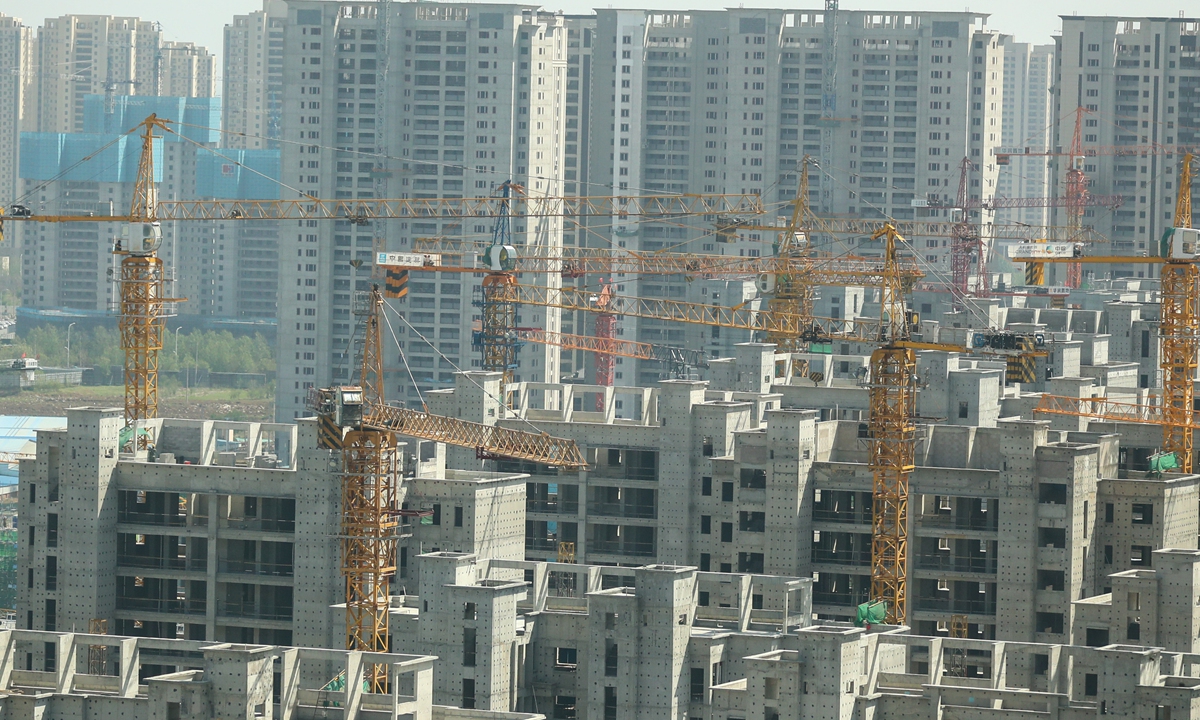China to crank up credit lines to 4 trillion yuan for eligible ‘white list’ housing projects by year-end: official

A housing project under construction in Shenyang, Northeast China’s Liaoning Province on Monday. The National Bureau of Statistics said that from January to April, national real estate development investment was 4.02 trillion yuan ($624 billion), a year-on-year increase of 21.6 percent. Photo: cnsphoto
China plans to expand bank credit lines for the “white list” housing projects to 4 trillion yuan ($562 billion) by the end of 2024, to encompass all qualifying property projects in the list to stabilize the real estate market, Ni Hong, Minister of Housing and Urban-rural Development, said at a press conference on Thursday.
“We will strive to ensure that all eligible housing projects are included and receive the necessary loans, satisfying their reasonable financing requirements,” Ni said.
As of Wednesday, bank loans extended to the eligible “white list” housing projects have reached 2.23 trillion yuan. It is expected that by the end of 2024, the approved credit lines will double, exceeding 4 trillion yuan, Xiao Yuanqi, deputy head of the National Financial Regulatory Administration, said at the same press conference.
Since the beginning of this year, the administration has collaborated with housing and urban development authorities to establish a streamlined financing mechanism to include all eligible real estate projects in the “white list,” encouraging financial institutions to strengthen their support for financing the project, Xiao said.
“After careful consideration, we have determined that the conditions are now in place to include all commercial housing development projects in the ‘white list.’ All housing projects that meet the criteria should be managed accordingly, ensuring that all eligible projects have access to bank loans,” Xiao said.
For projects on the “white list,” the country’s commercial banks should provide full credit support. “We have already guided lenders to step up efforts to ensure loan disbursement progresses on a project-by-project basis,” Xiao said.
Xiao also emphasized the need to optimize loan disbursement, to ensure prompt release of funds. Loans should be promptly transferred to the accounts of the “white list” real estate companies, allowing them to pay upstream suppliers – such as cement and steel makers – and construction firms early. “This will help ensure that housing projects can start construction on time, or even ahead of schedule,” Xiao noted.
Yan Yuejin, vice president at Shanghai-based E-house China R&D Institute, explained on Thursday that the "white list" system is a key tool in ensuring the completion of urban housing projects now. For property developers, this system is closely tied to alleviating their financial burdens, Yan said.
The policy will enhance homebuyer confidence, as the delivery timeline and housing quality are guaranteed. As a result, this will not only help shore up market confidence but also foster sustained market growth, stabilizing the real estate sector and reversing its decline, Yan said.
Ni outlined a comprehensive “policy package” including “four cancellations, four reductions, and two increases” to stabilize the housing market and promote its recovery.
The “four cancellations” involve granting the municipal governments greater autonomy in policy-making. Local governments are encouraged to tailor measures to their specific conditions by modifying or eliminating previous housing restrictions, by removing purchase restrictions, resale restrictions, price controls, and distinctions between ordinary and non-ordinary residential properties, Ni said.
The "four reductions" focus on lowering the interest rate on housing provident fund loans, reducing the down payment ratio, cutting the interest rates on existing mortgages, and easing the tax burden on selling old homes and purchasing new ones.
The "two increases" refer to, firstly, initiating the renovation of 1 million units in downtowns and dilapidated housing through monetary resettlement and other methods, and secondly, to expand the credit scale for the ‘white-listed’ housing projects to 4 trillion yuan by the end of this year, according to Ni.
Following three years of consistent policy adjustments, China’s housing market, under the support of a series of reform policies, has begun to show signs of bottoming out now, Ni said, adding that latest October data is expected to show favorable and encouraging results.
Global Times

